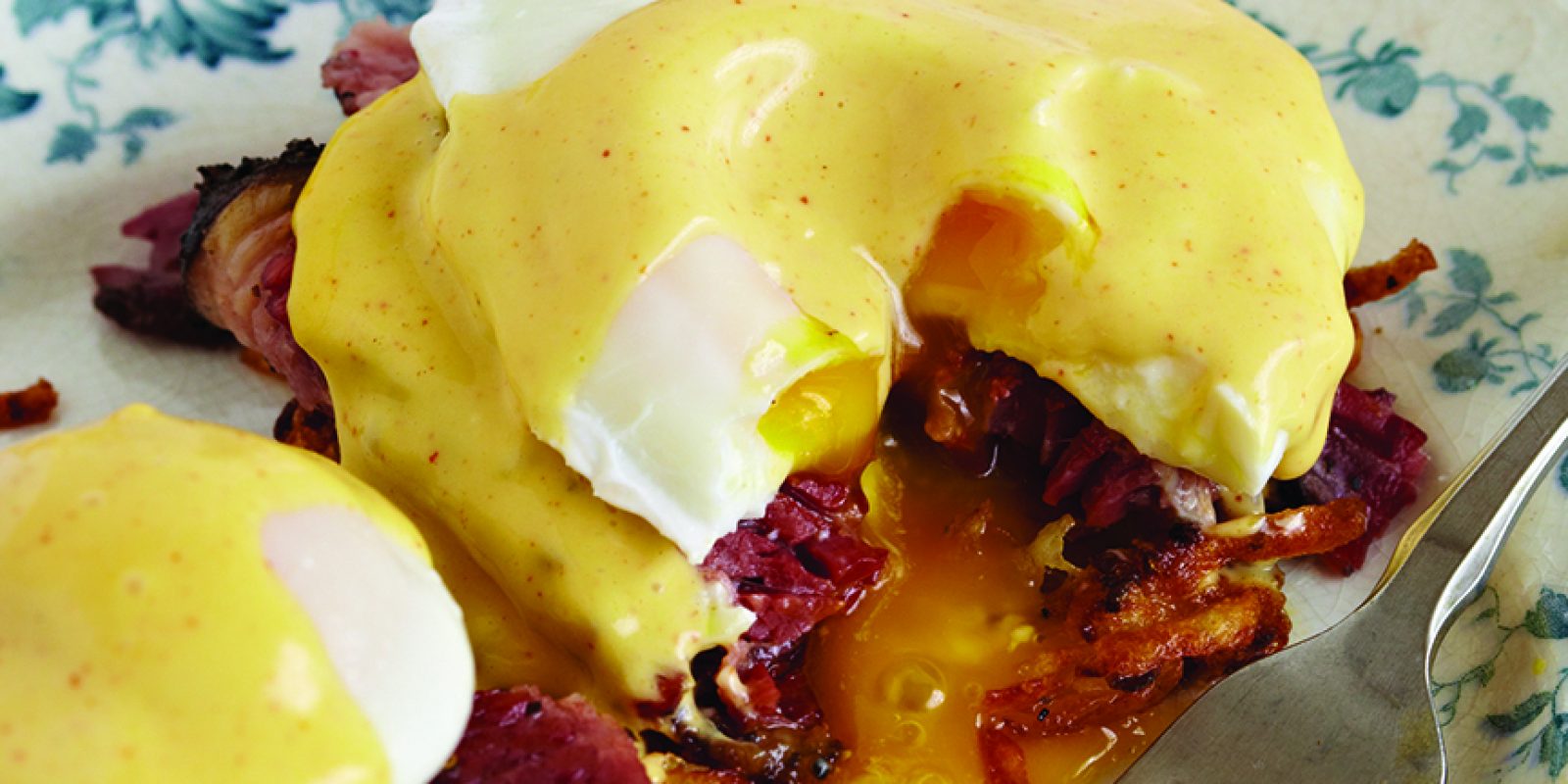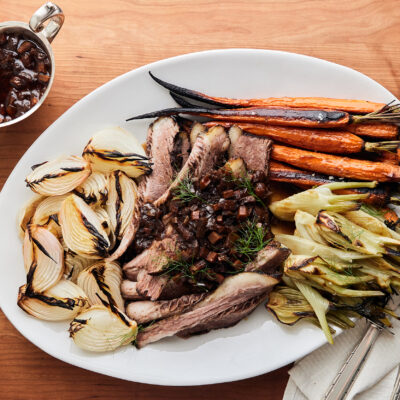From The Artisan Jewish Deli at Home
By Nick Zukin & Michael Zusman
Eggs Benedict is a luxurious breakfast dish rumored to have originated in New York City as a luncheon offering at the legendary Delmonico’s restaurant. This twisted modern Jewish deli version was adopted at Stopsky’s in Seattle. While the hollandaise and poached eggs are the same as in the original Benedict, latkes substitute for bread and pastrami for Canadian bacon. This recipe takes a little extra effort to put together. However, if you have made ahead and frozen some of our Crispy Potato Latkes (page 36), the preparation time can be cut in half. Any premium-quality pastrami will suffice in this dish, though naturally we think our Home-Oven Pastrami works best.
Pastrami Benedict
Ingredients
Hollandaise Sauce
- 5 large egg yolks
- 1 tablespoon Dijon mustard
- Juice of 1 lemon
- ½ teaspoon kosher salt
- ⅛ teaspoon cayenne pepper
- ½ cup (1 stick) unsalted butter, melted and kept hot
Pastrami Benedict
- 8 Crispy Potato Latkes (see recipe below)
- 1 ¼ pounds pastrami, sliced or coarsely chopped
- 8 large eggs
- 2 teaspoons distilled white vinegar or freshly squeezed lemon juice
- 2 tablespoons chopped fresh flat-leaf parsley
Crispy Latkes
- 1 pound Russet potatoes
- 1½ medium (8 ounces) yellow or white onions
- 1½ teaspoons kosher salt
- ½ teaspoon freshly ground black pepper
- 2 tablespoons all-purpose flour
- 1 large egg
- 1½ cups vegetable oil or Chicken Schmaltz
- 1 cup Chunky Ginger Applesauce (optional)
- 1 cup sour cream (optional)
Instructions
Preheat the oven to 200°F. Line two large rimmed baking sheets with paper towels.
To make the sauce, place the egg yolks, mustard, lemon juice, salt, and cayenne in a blender and blend on medium speed until frothy. With the blender running, pour in the hot melted butter in a slow, steady stream.
Be sure not to add the butter too fast or the sauce will break. If needed, add warm water, 1 tablespoon at a time, to thin the sauce to a consistency that will coat the back of a spoon. Taste and adjust the seasoning. Cover the sauce to keep warm.
Place the latkes (recipe below) on one of the lined baking sheets and put them in the oven to warm up.
In a large skillet over medium heat, and working in two batches, fry the pastrami, turning once or twice, until it is hot, about 5 minutes. Transfer the pastrami to the other lined baking sheet and put it in the oven to stay warm.
To poach the eggs, bring about 2 inches of water to a boil in a large skillet. When the water boils, add the white vinegar. Decrease the heat so the water is just below a simmer. One at a time, crack the eggs into a small bowl and slip them into the water. After about 3 minutes, use a slotted spoon to lift the first egg to see whether the white has completely set. When the whites are set, remove the eggs with a slotted spoon and gently blot the excess water with a clean kitchen towel. Transfer the eggs to a large plate and, if desired, use a paring knife to trim any ragged edges from the whites. Cover the eggs to keep them warm.
To serve, warm the serving plates. With the sauce nearby, remove the latkes and pastrami from the oven. Place 2 latkes on each plate. Pile some of the pastrami on top of each latke. Place a poached egg on top of each stack, and then spoon a generous amount of hollandaise sauce over the top. Garnish with the parsley and serve immediately.
Crispy Potato Latkes
Latkes are a labor-intensive delicacy associated with the late fall or winter celebration of Hanukkah, the Jewish Festival of Lights. However, these traditional potato pancakes are delicious any time of year. It used to be that the sign of a dedicated latke maker was scraped knuckles from hand-grating potatoes and onions with a box grater, or even worse, the old standup grater that looked like a miniature washboard. For all but the most devout traditionalist, the food processor has taken the worst of the labor (and likelihood of injury) out of the equation. Use a coarse grating disk for the potatoes after slicing them in quarters lengthwise to fit into the feed tube. For the onions, grate them in the food processor using either the fine grating disk or by pulsing the onions into a fine mince using the metal blade. If you have Chicken Schmaltz (page 5) on hand, use it as a flavorful old-style frying medium in place of vegetable oil. But you didn’t hear that from us.
Instructions
Servings: Makes 6 or 7 latkes
Fill a large bowl with ice water. Peel and grate the potatoes, placing the potatoes in the ice water to keep them from discoloring. Peel and grate the onions. Put the onions into a fine-mesh strainer and use your hand to press down until most of the liquid is drained. Drain the potatoes and dry them thoroughly using a salad spinner, paper towels, or a clean kitchen towel.
Place the potatoes, onions, salt, pepper, and flour in a large bowl and thoroughly mix the ingredients together. Add the egg and mix again until it is completely incorporated.
Preheat the oven to 200°F. Place a large skillet over medium heat. Add the oil and heat it until hot. Test the oil by dropping a small amount of the latke batter in the oil. If the batter bubbles and fries immediately, the oil is ready.
Measure ⅓ cup of the latke batter and place it between your hands, squeezing it, allowing most of the liquid to drain back into the bowl. In your hand, flatten the batter into a patty and place it gently in the hot oil. To minimize the risk of splattering, place the patty on a spatula and then use a fork or knife to slide the patty from the spatula into the oil. Repeat the process with as many patties as can fit into the skillet without crowding the pan. Cook until the underside is dark golden brown and crisp, about 5 minutes. To prevent uneven frying, the latkes can be rotated 180 degrees halfway through the cooking time.
Flip each latke, flattening it with the back of a spatula, and cook until dark golden brown and crisp on the second side, about 4 minutes, rotating them for even browning halfway through the cooking time.
Transfer to a heatproof platter or baking sheet lined with a double thickness of paper towels. Keep warm in the oven while you fry additional batches. Serve with applesauce or sour cream, if desired. The latkes can be held in a 200°F oven for up to 30 minutes.
From The Artisan Jewish Deli at Home by Nick Zukin and Michael Zusman, Andrews McMeel Publishing, LLC







